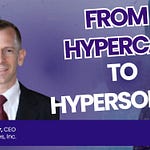Fortem Technologies - From Radar Innovation to Counter-UAS Leader
About Jon Gruen
Jon brings a unique combination of operational experience and defense industry knowledge to his role as CEO of Fortem Technologies. After graduating from the U.S. Naval Academy, he served 10 years on active duty as a Navy SEAL, including multiple deployments to Afghanistan and Iraq during Operations Enduring Freedom and Iraqi Freedom.
His transition to the private sector began in 2007 when he joined the Navy Reserve while simultaneously building his commercial career. He spent 11 years at Lockheed Martin learning acquisition processes and big program management, while concurrently commanding unmanned aerial system units in the reserves for four years. This dual perspective gave him front-row seats to both the traditional defense contracting world and the emerging defense innovation ecosystem.
Before joining Fortem, Gruen worked as an operational consultant helping multiple aerospace and defense startups navigate the valley of death. He took the helm at Fortem in 2022.
About Fortem Technologies
Founded in 2016 by Adam Robertson, Fortem Technologies began as a radar company leveraging Robertson's decades of experience developing military radars, particularly for IED detection during the Wars on Terror. Robertson's breakthrough was creating an architecture that enabled very low size, weight, power, and cost (SWAP-C) radar systems.
The company's evolution accelerated when DARPA recognized the potential of their small radar technology and suggested mounting it on drones in 2018. This led to Fortem developing comprehensive counter-UAS solutions spanning the entire detect-to-mitigate spectrum:
Ground-based and airborne radars with edge computing and AI
Command and control software integrating multiple sensors
A family of counter-UAS drones using various effectors (nets, explosives, future high-powered microwave)
Man-portable systems that fit in commercial trucks for tactical mobility
Fortem has been operationally deployed in Ukraine for over three years, working with border guards and other units while providing real-time intelligence on electronic warfare environments to U.S. government agencies. They've also developed significant homeland security capabilities, becoming the only approved kinetic solution for safely removing drone threats in the continental United States.
Key Takeaways
1. Anticipatory Tech Development is Winning
Fortem began developing counter-UAS solutions in 2016 when the primary concern was "nuisance" drones - hobbyists flying near military bases. While competitors focused on heavy, fixed-site solutions for this limited threat, Fortem anticipated that small commercial drones would proliferate and weaponize. This foresight positioned them ahead of the market when Ukraine demonstrated the reality of drone warfare.
2. Operational Deployment Builds Unmatched Credibility
Rather than relying on controlled demonstrations, Fortem invested in three years of active deployment in Ukraine's electronic warfare environment. This real-world experience allowed them to provide intelligence to U.S. agencies before official channels could detect threats, establishing credibility that marketing campaigns cannot replicate. Battlefield validation opened doors and contracts that polished presentations never could.
3. Differentiate Through Constraint-Driven Innovation
Fortem's "soft kinetic" approach (nets, parachutes) emerged from homeland security constraints that prohibit explosive countermeasures. This limitation became a competitive advantage, enabling forensic evidence collection for law enforcement while avoiding collateral damage. Companies should view regulatory and operational constraints as innovation drivers rather than obstacles.
4. Policy Advocacy Is Product Development
Despite having superior technology, Fortem's growth is constrained by policy gaps where Congress provided authorities without budgets, and agencies received budgets without exercising authorities. Gruen recognized that sustained policy advocacy is as crucial as R&D investment. Defense tech companies must allocate resources to navigate bureaucratic processes, not just technical challenges.
5. Mission-First Culture Attracts Top Talent and Customers
Gruen's emphasis on "saving lives" over "raising rounds" reflects a mission-driven culture rooted in his special operations background. This approach attracts both talent who want meaningful work and customers who need proven solutions. In an industry increasingly driven by venture hype, authentic mission focus becomes a differentiator that builds long-term competitive advantages.
For more on Fortem: fortemtech.com
For more Crossing the Valley: valleycrossers.com









